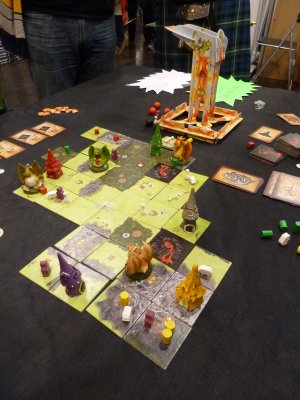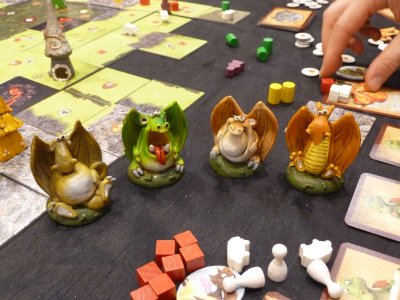

![[IMAGE]](../bilder/drascro1.jpg) |
Designer: Publisher: No. of Players: |
![[IMAGE]](../technik/box/rot/rot-5.gif) ![[IMAGE]](../technik/box/gelb/gelb-9.gif) ![[IMAGE]](../technik/box/grun/grun-4.gif) ![[IMAGE]](../technik/box/pink/pink-5.gif) ![[IMAGE]](../technik/box/blau/blau-8.gif) |
|
Usually the roles in fantasy boardgames are clearly defined: On the one side you have the player characters - wondrous wizards and valiant fighters who are trying to save the world from some monsterous threat - and on the other side you have the hordes of monsters who are managed by the game itself and are waiting to be killed by the heroes. But the Lamont brothers would not be known for producing unusual games if they weren't able to come up with an unexpected variation of this setting, and so their new game Dragonscroll lets the players take the role of some dragons roaming the countryside, ready to snack on stinky Orcs, vain Knights, wimpy Elves, dumb Dwarves and pesky Wizards. Sounds like a typical setting for a FRAGOR game, doesn't it? And indeed - jokes and puns are inevitable.
Each player begins the game with a little dragonling, and for setup a layout of two times two landscape tiles is placed on the center of the table with the dragons taking position on these landscape tiles. During his turn, a player first will reveal a newly drawn landscape tile from the common stock, and then he has to add it to the already known lands in a way which matches the landscape shown on the tile. The available types of landscapes are pastures, woods and mountains, and during the game connected areas of each of these types will be created by the players. In addition, the player also places foes onto the newly placed tile as indicated on the tile, so that the gameboard will contain a growing number of foes with each new tile.
![[SPIEL]](../specials/messe/essen14/ess14143.jpg) However, the foes are not just nice decoration - they are here to be eaten by the players' dragons, and so the active player may move his dragon after finishing the placement of tile and foes. A dragon may be moved for an indefinite number of landscape tiles, unless he changes the terrain which forces the dragon to stop after the first step onto new terrain. If there are any foes on the tile where the dragon stops (or Orcs on surrounding tiles) it will be time for fireballs! Rolling dice? How boring! A nifty combat mechanism based on cardplay and in-depth analysis? Too complicated! No, when the Lamonts are talking about fireballs, it's indeed balls of fire! So, the game contains a carboard construction called The Flaming Tower of Death, and the active player will throw a number of fireball-marbles into the Tower which corresponds to his Dragon's current strength. The Tower has four exists, and depending on the exit taken by each fireball a matching foe now may be eaten. However, things are a bit more tricky as it may seem, and so a Dragon is obliged to eat all foes within range in a single attack. As indicated, foes on the same space and Orcs on surrounding spaces are in range, but in addition all Elves within the same wood or Dwarves within the same Mountain range are considered to be in range, and so the right space for a Dragon attack needs to be chosen well if the player wants to succeed at full extend. If not all creatures can be defeated, the player may still keep the defeated foes but he must also take a token which will cost him one victory point by the end of the game. If too many battles end this way, a considerable amount of victory points will be lost to the player.  Defeated foes can be collected, and they can be used either for increasing the Dragon's strength (more fireballs!) or for fulfilling "Munching"-quests on special Dragonscroll cards. Each player starts with three of these Dragonscroll cards, and additional cards can be acquired during the course of the game. If the player hands an amount of defeated foes which matches the requirements of one of his cards back to the stockpile, he may place this card beneath his Dragon's character card, continuing his storyline and counting as victory points by the end of the game. Two more types of Dragonscrolls exist, and these are "Discovery" cards which the player can score by completing landscape formations, and "Fireball" cards which require a certain number of foes to be defeated in just one turn. If fulfilled, these cards can be revealed and scored as well. Coincidentally, this triple way of scoring resembles a bit of the landscape, growing and eating scoring possibilities found in Takenoko, but this similarity is only superficial because the scoring options have been embedded in a quite different playing mechanism. A quite cool "Lamontish" idea is the fact that each fulfilled card is placed beneath the player's Dragon to reveal a piece of story, and at the end of the game each player's Dragon will have developed a quite various storyline. The basic playing mechanism outlined above is enriched further by some other elements, and so some of the landscape tiles actually list cities which will be placed on them. When a Dragon does battle on a space neighbouring a city, a black Wall marble will be put into the Tower amongst the fireballs, and all fireballs leaving the Tower on the same side as the Wall marble will be useless because the foes listed on this side will hide behind the city walls - those dirty cowards! Of course all this could have been reached the one or other way by the use of dice, but once you have started fireballing your foes you will quickly discover that the use of the Tower is much more amusing and fits the general spirit of the game quite well. Another specialty not listed yet are the Wizards and the members of the Royal Family. Wizards are pesky indeed, and whenever a Wizard is discovered the player will draw a Wizard card which lists the abilities of this specific Wizard. In game terms this usually means that the combat gets more difficult (by adding the wall marble etc.), and so Wizards are not easy to fool! Members of the Royal Family can be collected and munched as well, but since the Dragons recognize noble blood it is much more reasonable to keep them and deliver them to their home city in order to collect a nice reward. ![[SPIEL]](../specials/messe/essen14/ess14144.jpg) Finally, to introduce a bit more of tactics, each player receives a Destiny card which is revealed by the end of the game, and these cards allow the players to score bonus victory points for certain conditions. On the other hand, the players also get a deck of three bonus action cards, and each turn one of these cards must be used to draw and place an additional landscape tile, to draw a Dragonscroll card or to get a temporary additional fireball. However, after its use the card is turned over and reveals another bonus action, so that not every action will be available every turn. After their strategic deckbuilding game Spellbound the Lamonts now have returned to the sector of family boardgames. With the hilarious Tower and the fireball-marbles, the game certainly offers a good degree of fun and chaotic moments, but as the outline above should prove there is more mechanism and depth than may seem on first sight. Just like the Big Wave in Poseidon's Kingdom, the Flaming Tower of Death is not just a typical trademark of a FRAGOR game, but it serves its own special function and it is part of a nice and entertaining family game of medium playing depth. Of course, the Lamonts could have used dice - but on the one hand dice with four sides are not really nice to roll, and in addition this would also have required special dice for walls etc.. So, the Tower is not just more freaky, it really serves its purpose better than a bunch of dice. There is also some potential for tactics, and the players certainly need to ponder their chances to win a battle against a high number of foes, so that it may well pay off to approach smaller groups of foes in order to leave the battlefield victorious. Coming with the typical resin figures and an unusual thematic background, Dragonscroll once again is a real gem which stands out from the usual mainstream of family games. Let's hope it will become available for a larger audience as a new edition!  | ||
|
| ||

|
|

|
|
| ||
|
Impressum / Contact Info / Disclaimer Kulkmann@aol.com
Copyright & copy; 2014 Frank Schulte-Kulkmann, Essen, Germany | ||